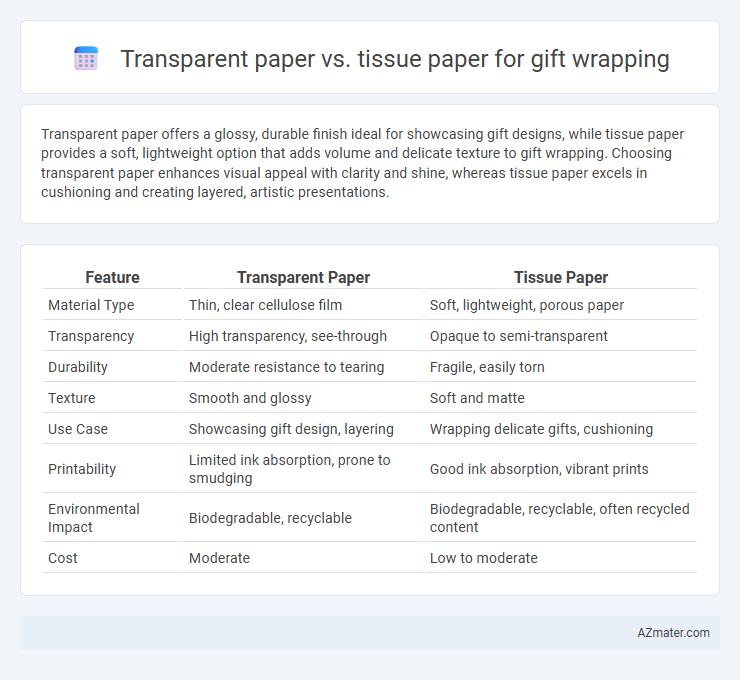Transparent paper offers a glossy, durable finish ideal for showcasing gift designs, while tissue paper provides a soft, lightweight option that adds volume and delicate texture to gift wrapping. Choosing transparent paper enhances visual appeal with clarity and shine, whereas tissue paper excels in cushioning and creating layered, artistic presentations.
Table of Comparison
| Feature | Transparent Paper | Tissue Paper |
|---|---|---|
| Material Type | Thin, clear cellulose film | Soft, lightweight, porous paper |
| Transparency | High transparency, see-through | Opaque to semi-transparent |
| Durability | Moderate resistance to tearing | Fragile, easily torn |
| Texture | Smooth and glossy | Soft and matte |
| Use Case | Showcasing gift design, layering | Wrapping delicate gifts, cushioning |
| Printability | Limited ink absorption, prone to smudging | Good ink absorption, vibrant prints |
| Environmental Impact | Biodegradable, recyclable | Biodegradable, recyclable, often recycled content |
| Cost | Moderate | Low to moderate |
Introduction: Choosing the Right Gift Wrapping Material
Transparent paper offers a sleek, modern look that highlights the gift inside while providing a durable wrapping option resistant to tearing. Tissue paper is softer and more pliable, ideal for adding volume and delicate cushioning to gift packaging. Selecting between transparent paper and tissue paper depends on the desired aesthetic effect and the type of gift being wrapped.
What is Transparent Paper?
Transparent paper, also known as glassine, is a smooth, glossy, and semi-transparent material made from highly refined cellulose fibers. It is resistant to grease, air, and water, making it ideal for protecting delicate items while allowing visibility of the contents underneath. Often used for gift wrapping, transparent paper offers a sleek, modern aesthetic and enhances the presentation by showcasing the gift without fully concealing it.
What is Tissue Paper?
Tissue paper is a lightweight, thin paper commonly used for gift wrapping, known for its delicate texture and vibrant colors that add an elegant touch to packaging. Unlike transparent paper, tissue paper is opaque and soft, allowing it to provide cushioning and prevent damage to fragile items inside gift boxes or bags. Its versatility and affordability make tissue paper a popular choice for enhancing the presentation and protection of wrapped gifts.
Visual Appeal: Transparent vs Tissue Paper
Transparent paper offers a sleek, modern look by showcasing the gift inside, enhancing the visual appeal through a glossy, see-through finish that highlights colors and textures beneath. Tissue paper provides a soft, delicate aesthetic with its matte, opaque surface, adding layers of vibrant or pastel hues that create an inviting, textured presentation. Choosing between transparent and tissue paper depends on whether the goal is to emphasize the gift's contents or to complement it with subtle, decorative softness.
Durability and Protection of Gifts
Transparent paper offers moderate durability and provides a smooth, glossy finish that showcases the gift while offering basic protection against dust and dirt. Tissue paper, being thinner and more delicate, is less durable but excels in cushioning fragile items, preventing scratches and minor impacts during handling. For optimal protection, combining transparent paper with tissue paper enhances both aesthetic appeal and safeguard, ensuring gifts remain intact and visually appealing.
Versatility in Gift Wrapping Styles
Transparent paper offers exceptional versatility in gift wrapping by showcasing the gift's design while adding a glossy, protective layer that enhances presentation. Tissue paper excels in creating delicate, layered looks that add softness and volume to gifts, perfect for intricate decorative styles such as bows and ruffles. Combining both materials can elevate wrapping, blending transparency with texture for a dynamic, multi-dimensional appearance.
Eco-Friendliness and Sustainability Comparison
Transparent paper offers a more sustainable choice for gift wrapping due to its recyclable and biodegradable properties, often produced from renewable resources like cellulose. Tissue paper, while lightweight and reusable, can vary in eco-friendliness depending on its manufacturing process and dye content, sometimes complicating recycling efforts. Choosing transparent paper reduces environmental impact by minimizing waste and promoting easy recycling, supporting greener gifting practices.
Cost Analysis: Transparent Paper vs Tissue Paper
Transparent paper typically costs more than tissue paper due to its durability and glossy finish, making it a premium option for gift wrapping. Tissue paper is more affordable and available in bulk, which reduces overall expenses for large-scale wrapping needs. Choosing between the two depends on budget constraints and the desired aesthetic for the gift presentation.
Creative Gift Wrapping Ideas
Transparent paper offers a sleek, modern look that highlights the gift inside, making it perfect for layering with colorful tissue paper for a dynamic, textured effect. Tissue paper adds softness and volume, ideal for creating fluffy bows or intricate folds that enhance the gift's presentation. Combining both materials allows for creative gift wrapping ideas such as using transparent paper as an outer shell to showcase decorative tissue paper patterns underneath.
Which Paper is Best for Your Gift: Final Verdict
Transparent paper offers a glossy, modern finish perfect for showcasing the gift inside while adding a layer of protection against moisture and dust. Tissue paper provides a soft, delicate texture ideal for cushioning fragile items and creating a traditional, elegant presentation. Choosing the best paper depends on your priority: use transparent paper for visibility and sophistication, while tissue paper is preferred for softness and classic wrapping aesthetics.

Infographic: Transparent paper vs Tissue paper for Gift wrapping
 azmater.com
azmater.com